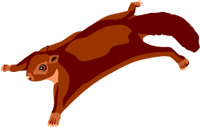Vertebrate Flight
GLIDING AND PARACHUTING
As discussed previously, the difference between powered flight and gliding is the flight stroke, which produces thrust in true flyers. Gliders, then, do not produce thrust; they do not flap their wings. Indeed, a glider might compromise its lift production (i.e., fall) if it tried to do so — its gliding membrane would be too small to maintain enough lift to keep the animal aloft.
When looking at the structure of an animal, without knowing its behavior (whether it flies or not) we can note some common differences between typical flyers and gliders. Most importantly, flyers have an elongated distal wing, which is flapped to produce thrust. To flap the wings, they need strong shoulder muscles, so a keeled sternum (breastbone), large humerus (upper arm bone), and modified shoulder girdle are indicative of powered flight. Also, the forearms of flyers are more elongated than in gliders, although the hands exterior to the wing are usually small. Flyers need a rigid, confined power stroke to enhance stability, so motion of the arms should be limited by the joints that are involved in the flight stroke. And the wing should be stiffened by some structural elements (e.g., fibers in pterosaurs, feathers in birds, fingers in bats).
In contrast, gliders usually retain the locomotory abilities of their ancestors, most notably climbing and leaping adaptations (which include mobile joints and large hands). Some gliders have elongated ribs which support the gliding membrane (no flyers do this). Aerodynamically, gliders are less maneuverable (although they can still be very maneuverable) and have a lower aspect ratio (wing length/wing breadth) than flyers. So, if we find the remains of an animal, we can be pretty sure whether it glided or flew.
Some Examples of Gliders and Parachuters
Parachuters: Few vertebrates simply parachute as a mode of aerial locomotion; most parachute when they are airborne, and normally get around using another form of locomotion. For example, cats normally walk, but if you drop a cat, it spreads out its body to maximize its drag forces, acting as a parachuter (please, don't try this at home). Gliding is in some senses a modified form of parachuting, in which lift forces are produced by an airfoil-type membrane, so most gliders could also be considered part-time parachuters. But true fliers, such as birds, often glide and parachute when this behavior is useful to them.
|
|
 |
Gliders: Gliding has evolved many times in vertebrates, but never has produced diverse lineages of gliders. You might think gliding is a good first step toward powered flight, but in fact we know of only one group (bats) that seems to have evolved from gliding ancestors, because bats retain many features of gliders. In contrast, the earlier birds and their theropod dinosaur relatives show no evidence of a gliding ancestry. And we don't know enough yet about the origins of pterosaurs. However, the many lineages of gliding animals today, including a host of lizards, squirrels (right), marsupials, and colugos show no signs of turning into flappers anytime soon. Some sample gliders:
Draco volans, the "flying dragon" lizard: A small arboreal agamid lizard that has elongate ribs that support the gliding membrane. Convergent with such extinct diapsids as the Permian Weigeltosaurus and the Triassic Icarosaurus (pictured below). UC Berkeley professors Robert Dudley and Jim McGuire have made extensive studies of Draco, its taxonomy, relationships, ecology and flight styles.

From left to right: Weigeltosaurus, Icarosaurus,
and Draco. (from Padian 1985)
Cynocephalus, the colugo, or "flying lemur": As is customarily said when mentioning the colugo, it is neither a flyer nor a lemur, but a member of the clade Dermoptera, which may be closely related to bats. It is a medium-sized arboreal gliding mammal which hangs upside down in trees, leaping into the air to glide in search of fruit to eat.
|
|
 |
Exocoetus, a "flying fish": This interesting actinopterygian fish seems to be on an evolutionary borderline between flight and gliding: it flaps its enlarged pectoral fins when airborne, but still seems only to glide, as there is no hint of a power stroke. The flying fish seem to use gliding in air as a way to escape predation: they swim quickly underwater, then, with a flick of the tail, launch themselves into the air, where they can glide long distances (see the Physics of Flight section to try to deduce why they can glide further in air than in water).
|
|
 |
Rhacophorus: An arboreal frog with expanded toe membranes which help it fall more slowly after it leaps off of trees. Professor Mimi Koehl at UC Berkeley has done some research on these interesting animals, and found that the frog is not just a parachuter, but uses gliding, possibly to quickly get through the air to its breeding ponds. The frog can maneuver while it is airborne, even making turns.
Next: The Evolution of Flight